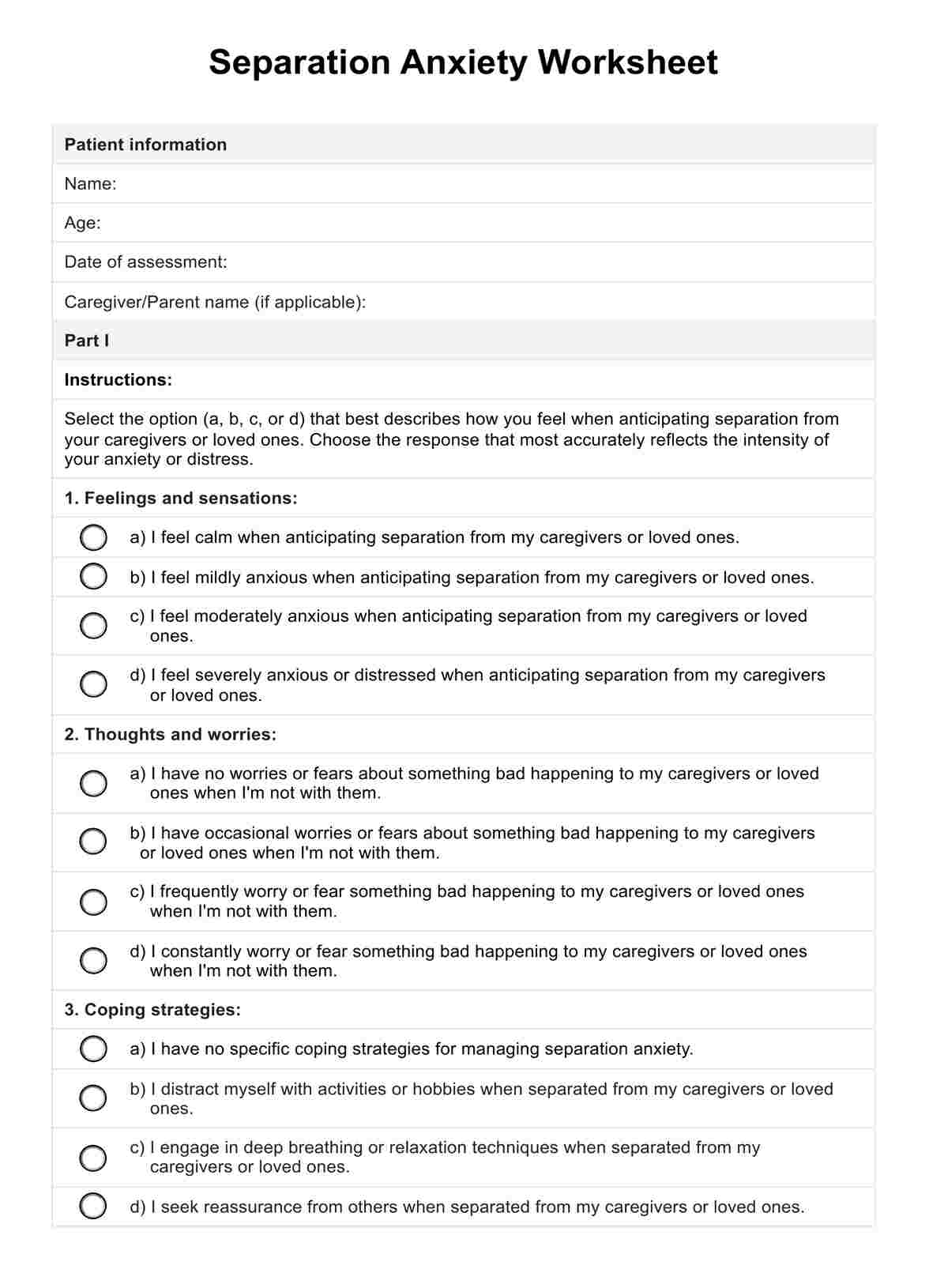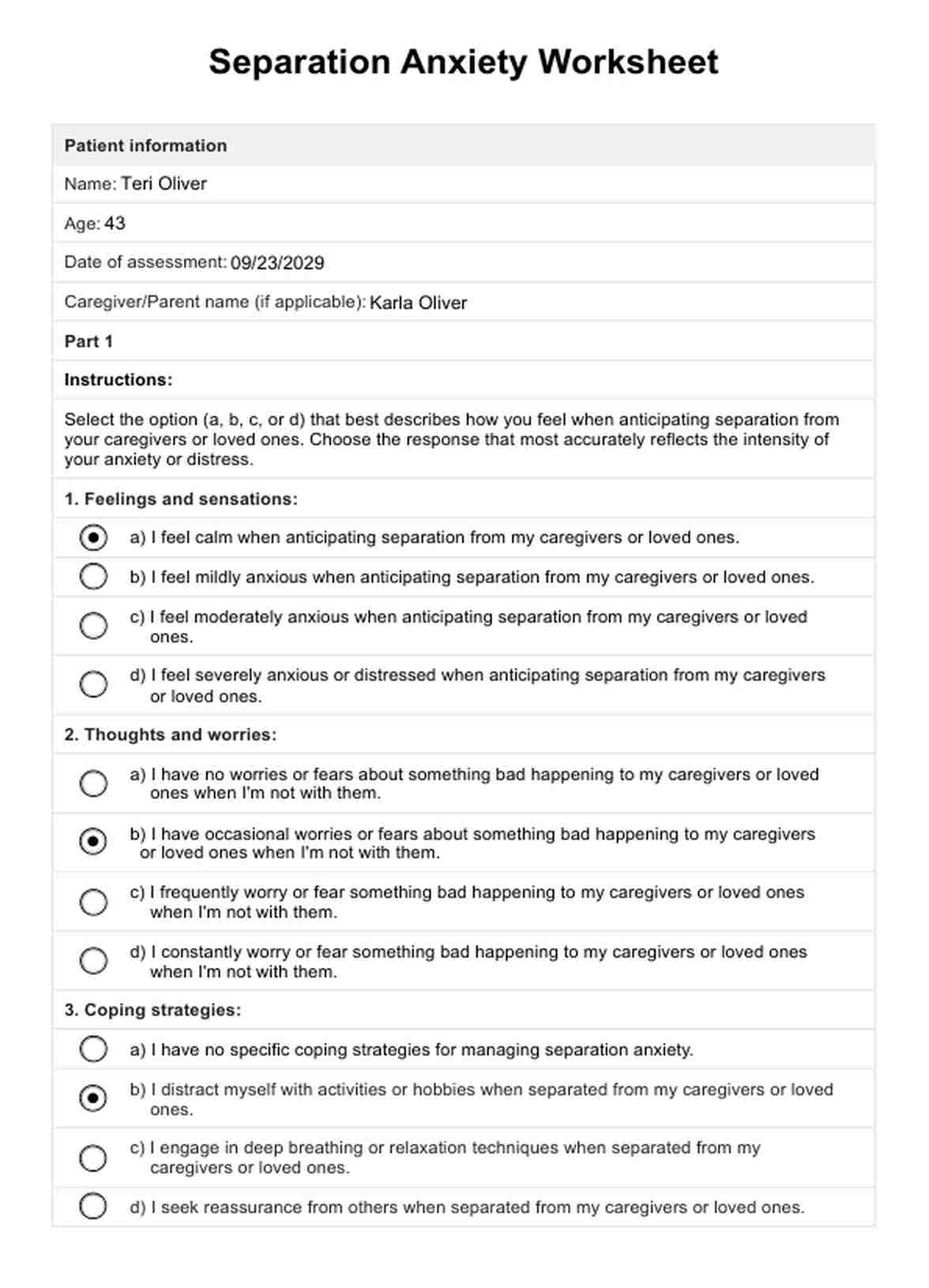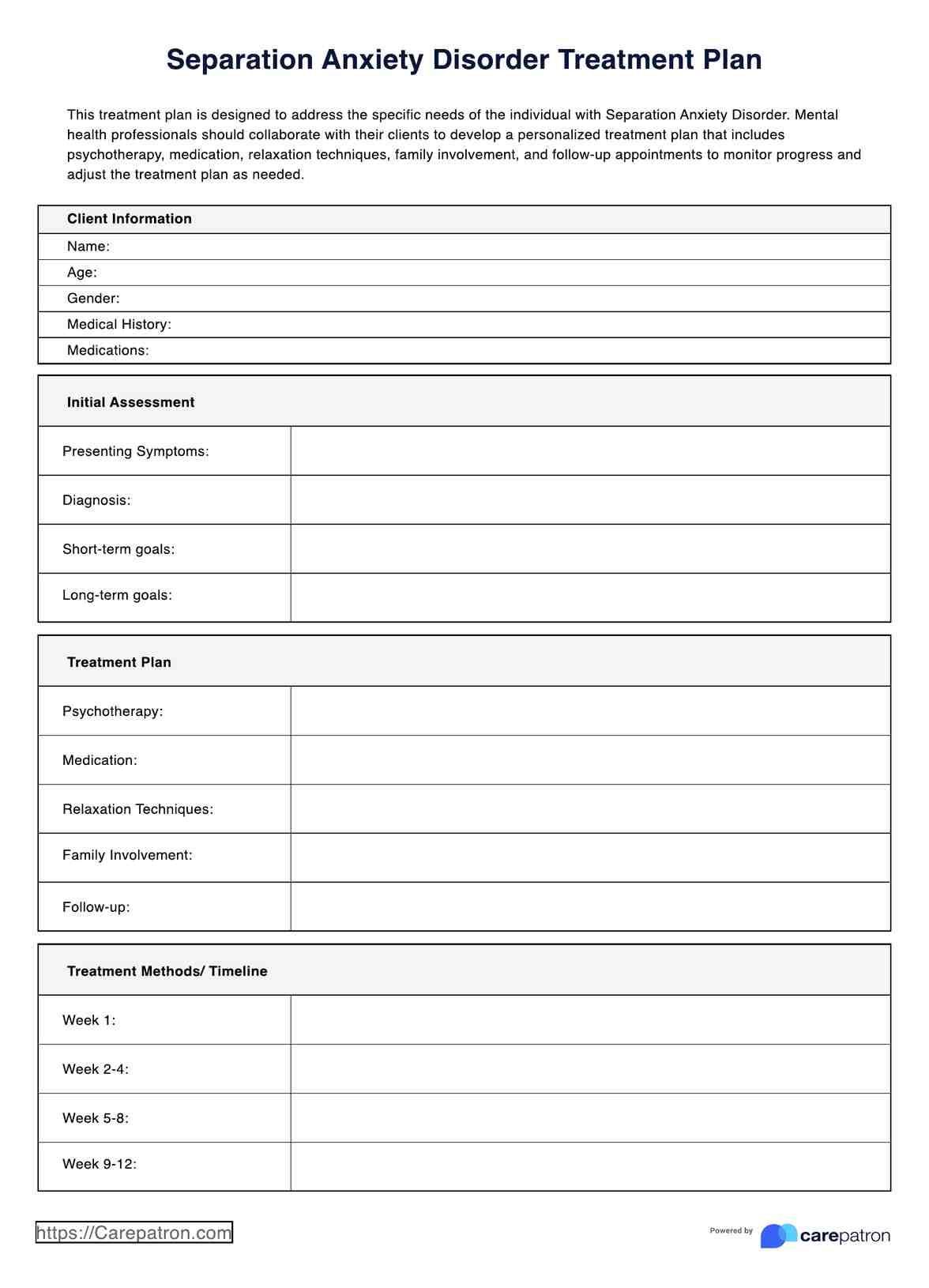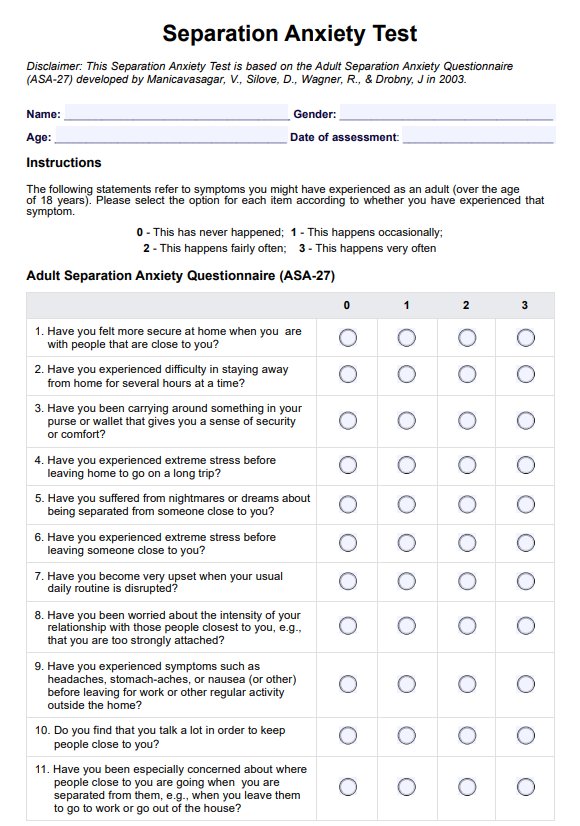Separation Anxiety Worksheets
Designed for mental health professionals, our Separation Anxiety Worksheets offer prompts to assess symptoms, triggers, coping mechanisms, and treatment strategies. Download today!


What is separation anxiety?
Separation anxiety is a natural part of kids growing up, typically beginning in infancy and fading away around age 3. It's characterized by an overwhelming fear of being apart from home or a primary caregiver, often a parent.
Distinguishing between regular separation anxiety and separation anxiety disorder (SAD) boils down to the severity of the child's fears and worries and whether they disrupt daily life and growth. SAD involves much stronger anxiety that isn't typical for the child's stage of development.
Difference between separation anxiety and separation anxiety disorder
The primary distinctions between typical separation anxiety and separation anxiety disorder lie in several key areas. In SAD, the intensity of the fears experienced by the child is notably heightened, often resulting in extreme distress even at the mere thought of separation.
While normal separation anxiety typically peaks between 6 to 12 months of age and gradually diminishes by age 3, SAD manifests as anxiety that is not developmentally appropriate for the child's stage. Additionally, SAD significantly disrupts daily activities, social interactions, school attendance, and performance, whereas regular separation anxiety does not impede functioning to such a considerable extent.
For a diagnosis of SAD, symptoms must persist for at least four weeks in children under ages two and six months in adults, whereas normal separation anxiety tends to be transient and short-lived. Finally, while normal separation anxiety typically emerges in infancy, SAD may commence during childhood but can also onset during teenage years or adulthood in some instances.
Causes and risk factors of separation anxiety
The exact causes of SAD are unknown, but it likely involves a combination of genetic, biological, and environmental factors
- Family history of anxiety or depression
- Shy, timid personality
- Overprotective parenting style
- Lack of appropriate parental interaction
- Significant life stresses or losses (e.g., moving, divorce, death of a loved one)
- History of traumatic events in childhood
Symptoms of separation anxiety in children
Symptoms of separation anxiety disorder in Children can be observed through various manifestations, such as:
- Recurrent and excessive distress when anticipating or being away from home or attachment figures
- Persistent worry about losing major attachment figures or potential harm befalling them
- Continued concern about experiencing a negative event that causes separation
- Reluctance or refusal to go out, attend school, work, or be away from home
- Excessive fear of being alone
- Resistance to sleeping away from home or without a major attachment figure present
- Repeated nightmares with themes related to separation
- Frequent complaints of physical symptoms (e.g., headaches, nausea) during separation or its anticipation
Symptoms of separation anxiety in adults
Symptoms of separation anxiety in adults are characterized by heightened anxiety levels and potential panic attacks triggered by separation from loved ones. These symptoms may include:
- Extreme fear of potential harm befalling a loved one
- Excessive worry surrounding separation from loved ones
- Avoidance of solitude
- Physical manifestations such as headaches, nausea, or stomachaches upon separation
- Difficulty sleeping when away from home or loved ones
- Nightmares centered around the theme of separation
Separation Anxiety Worksheets Template
Separation Anxiety Worksheets Example
How to diagnose separation anxiety?
Separation anxiety disorder is diagnosed through a thorough clinical assessment, employing a structured interview and evaluation of symptoms according to Diagnostic and Statistical Manual of Mental Disorders, Fifth Edition, (DSM-5) criteria. This process entails various components, beginning with a clinical interview conducted by a mental health professional, which involves discussing the child's thoughts, feelings, and behaviors related to separation, observing their behavior in separation scenarios, and obtaining a detailed symptom history from parents or caregivers.
Various assessment tools, such as the Screen for Child Anxiety-Related Disorders (SCARED) and Children's Separation Anxiety Scale (CSAS), are available to assist in diagnosis and treatment planning. However, they should complement, not replace, clinical judgment. Ultimately, an early and accurate diagnosis is crucial for effective intervention and preventing long-term complications associated with SAD.
Using the clinical interview template alongside the anxiety worksheet template can significantly boost your practice's effectiveness. The clinical interview template ensures a thorough and structured approach to gathering essential patient information, while the anxiety worksheet template helps in assessing and addressing specific anxiety-related issues.
How to treat separation anxiety?
Separation anxiety disorder can be effectively managed through a comprehensive treatment approach involving psychotherapy, medication, and parental support. Cognitive behavioral therapy (CBT) stands as the cornerstone of psychotherapeutic intervention, empowering children to comprehend and cope with their separation-related fears.
CBT encompasses teaching coping mechanisms to mitigate anxiety during separations, reshaping cognitive patterns to foster more adaptive behaviors, and employing techniques like systematic desensitization and relaxation exercises. Family therapy may complement CBT, aiding parents in understanding and assisting the child while addressing familial dynamics contributing to anxiety. In severe cases, medication, typically selective serotonin reuptake inhibitors (SSRIs), may be prescribed alongside CBT to alleviate symptoms and facilitate therapy effectiveness. Close monitoring is essential to evaluate response and manage potential side effects.
Parents play a pivotal role in their child's treatment journey by fostering a supportive environment, maintaining consistent routines, modeling calm behavior during separations, and implementing reward systems that encourage them to face fears. By combining these strategies and intervening early, separation anxiety disorder symptoms can be effectively managed, enhancing the child's well-being and preventing long-term complications.
Commonly asked questions
The Separation Anxiety Worksheet is primarily intended for completion by parents, teachers, caregivers, or mental health professionals who are working with children or adults experiencing separation anxiety.
The time required to complete the separation anxiety worksheet can vary depending on factors such as the complexity of the individual's symptoms, the thoroughness of the assessment, and the level of detail included in the worksheet.
The frequency of reviewing or updating the separation anxiety worksheet depends on several factors, including the individual's progress, the effectiveness of treatment interventions, and any changes in circumstances or symptoms. Generally, it is advisable to review the excessive anxiety worksheet regularly to ensure that the information remains accurate and relevant.























-template.jpg)


















































































